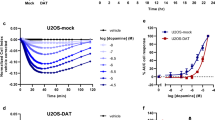Abstract.
Incubation of PC12 cells with the sulfonylurea drug, glipizide (1–100 µM), increased intracellular levels of the acidic metabolites of dopamine, 3,4-dihydroxyphenylacetic acid (DOPAC) and homovanillic acid (HVA). The levels of these acids in the medium were decreased, indicating the presence of a sulfonylurea-sensitive organic anion transporter. In the present study, we demonstrate that the sulfonylurea-sensitive transport of acidic dopamine metabolites is unidirectional, ATP dependent, unaffected by ouabain or by tetrodotoxin and blocked by drugs that interact with the multidrug-resistance protein-1 (MRP1). However, over-expression of MRP1 did not affect transport of the acid metabolites. The pharmacological profile and ion dependence of the transporter also differs from that of known ATP-binding cassette (ABC) family members. Using microdialysis, we also demonstrated a sulfonylurea-sensitive transport process in the striatum of freely moving rats. These results show that acidic dopamine metabolites are actively secreted from dopaminergic cells into surrounding extracellular fluid by a previously undescribed transporter.
Similar content being viewed by others
Author information
Authors and Affiliations
Additional information
Electronic Publication
Rights and permissions
About this article
Cite this article
Lamensdorf, I., Hrycyna, C., He, LP. et al. Acidic dopamine metabolites are actively extruded from PC12 cells by a novel sulfonylurea-sensitive transporter. Naunyn-Schmied Arch Pharmacol 361, 654–664 (2000). https://doi.org/10.1007/s002100000246
Received:
Accepted:
Issue Date:
DOI: https://doi.org/10.1007/s002100000246




